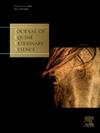Influence of two extenders used for short-cooled storage on motility of Quarter Horse semen submitted to a test freezing
IF 1.3
3区 农林科学
Q2 VETERINARY SCIENCES
引用次数: 0
Abstract
Identifying the most appropriate extender for short-cooled storage is essential for maximizing post-thawing results. The objectives of this study were assessing the impact of two extenders routinely used for cooled-storage on post-thaw progressive motility (PM) and identifying the most adequate freezing extender for these samples’ cryopreservation. One ejaculate from each of ten Quarter Horse stallions, routinely used in a reproduction center, was collected. Samples were randomly diluted in Botu-Semen (BS) (G1) (n=5) or EquiPlus (EP) (G2) (n=5) to 50 × 106 cells/ml and maintained at 5°C for 8 h, before being equally split into 9 tubes. They were centrifuged (600g x 20 min) and the pellet was resuspended with one of 9 different freezing extenders (Blue, Green, Orange, Red, Violet, Star, MX3, Gent and Botucrio) to 200 × 106 sperm/ml. Then straws were manually filled and kept at 5°C for 20 min in a refrigerator. Subsequently, they were exposed to nitrogen vapors for 20 min, before immersion in liquid nitrogen. Straws were thawed in a water bath at 37°C for 30 seconds. Evaluation of sperm PM after cooling storage (t0) and after thawing (t1) was performed using the CASA System (AndroVision, Minitube, Germany). A generalized linear model was used, being the response variable, PM, and the fixed effects, cooling extender (two levels: G1 and G2) and freezing extender (9 levels: each freezing extender). To analyze the number of samples with post-thaw PM ≥ 30% according to the cooling extender, a generalized linear model was used too. Differences were considered significant when P values were <0.05. Values are expressed as mean ± SD (Graph Pad, USA). Mean PM before freezing did not show significant differences between G1 and G2 (73.4±14.4% vs 72.8±4.3%, respectively). Post-thaw PM was significantly greater in samples of G2 vs. G1 (28.6±10.2% vs 16.15±10.2%) (P˂0.001). Moreover, 48.8% of samples of G2 showed post-thaw PM˃30%, while only 8.8% of G1 did (P˂0.01). Considering each stallion's performance, 5/5 individuals of G2 reached a post-thaw PM˃30%, while only 2/5 of G1 did. Samples of G2 showed a greater post-thaw PM when using STAR, Orange and Violet, compared to G1 (34.6±6.3% vs. 18.7±11.9%, 23.8±8.2% vs. 11.8±5.8% and 38.3±6.7% vs. 19.1±8.9%, respectively). Post-thaw PM˃30% was attained for 4/5 stallions of G2 whose sample was diluted in STAR and Botucrio, and for 5/5 whose sample was diluted in Violet. Only 1/5 stallions of G1 attained post-thaw PM˃ 30% (using STAR, Botucrio, Green and Violet). No interaction was observed between the cooling extender and the freezing extender. In general, mean PM decreased from t0 (73.1±10.1%) to t1 (22.4±11.9%) (P˂0.001). In conclusion, PM after-thawing was better when samples were stored in EP than in BS. Better results were accomplished when using Violet, Star and Botucrio as freezing extenders.
求助全文
约1分钟内获得全文
求助全文
来源期刊

Journal of Equine Veterinary Science
农林科学-兽医学
CiteScore
2.70
自引率
7.70%
发文量
249
审稿时长
77 days
期刊介绍:
Journal of Equine Veterinary Science (JEVS) is an international publication designed for the practicing equine veterinarian, equine researcher, and other equine health care specialist. Published monthly, each issue of JEVS includes original research, reviews, case reports, short communications, and clinical techniques from leaders in the equine veterinary field, covering such topics as laminitis, reproduction, infectious disease, parasitology, behavior, podology, internal medicine, surgery and nutrition.
 求助内容:
求助内容: 应助结果提醒方式:
应助结果提醒方式:


